Jesse and his brother
Frank James were Confederate
guerrillas during the Civil War. They were accused of participating in atrocities committed against
Union soldiers. After the war, as members of one
gang or another, they robbed banks,
stagecoaches, and trains. Despite popular portrayals of James as a kind of
Robin Hood, robbing from the rich and giving to the poor, there is no evidence that he and his gang used their robbery gains for anyone but themselves.
[2]The James brothers were most active with their gang from about 1866 until 1876, when their attempted robbery of a bank in
Northfield, Minnesota resulted in the capture or deaths of several members. They continued in crime for several years, recruiting new members, but were under increasing pressure from law enforcement. On April 3, 1882, Jesse James was killed by
Robert Ford, who was a member of the gang living in the James house and who was hoping to collect a state reward on James' head.
Early life
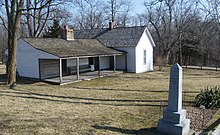
Jesse James Farm in Kearney.
Jesse Woodson James was born in
Clay County,
Missouri, near the site of present day
Kearney, on September 5, 1847. Jesse James had two full siblings: his older brother,
Alexander Franklin "Frank", and a younger sister, Susan Lavenia James. Across a creek and up a hill from the house on the right was the home of Daniel Askew, where Askew was killed on April 12, 1875. Askew was suspected of cooperating with the
Pinkertons in the January 1875 arson of the house (in a room on the left). James's original grave was on the property but he was later moved to a cemetery in Kearney. The original footstone is still outside, although the family has replaced the headstone.
After Robert James' death, his widow
Zerelda remarried twice, first to
Benjamin Simms and then in 1855 to Dr.
Reuben Samuel, who moved into the James' home. Jesse's mother and Reuben Samuel had four children together: Sarah Louisa, John Thomas, Fannie Quantrell, and Archie Peyton Samuel.
[3][5] Zerelda and Reuben Samuel acquired a total of seven slaves, who served mainly as farmhands in
tobacco cultivation in Missouri.
[5][6]Historical context
The approach of the
American Civil War overshadowed the James-Samuel household. Missouri was a border state, sharing characteristics of both North and South, but 75% of the population was from the South or other border states.
[3] Clay County was in a region of Missouri later dubbed "
Little Dixie," as it was a center of migration from the Upper South. Farmers raised the same crops and livestock as in the areas they migrated from. They brought slaves with them and purchased more according to need. The county had more slaveholders, who held more slaves, than in other regions. Aside from slavery, the culture of Little Dixie was Southern in other ways as well. This influenced how the population acted during and for a period of time after the
American Civil War. In Missouri as a whole, slaves accounted for only 10 percent of the population, but in Clay County they constituted 25 percent.
[7]After the passage of the
Kansas-Nebraska Act in 1854, Clay County became the scene of great turmoil, as the question of whether
slavery would be expanded into the neighboring Kansas Territory came to dominate public life. Numerous people from Missouri migrated to Kansas to try to influence its future. Much of the tension that led up to the Civil War centered on the
violence that erupted in
Kansas between pro- and anti-slavery militias.
[6][8]American Civil War
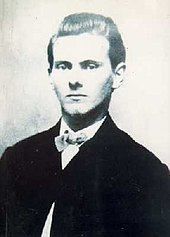
Jesse James (unknown date)
The Civil War may have shaped Jesse James' life. After a series of campaigns and battles between conventional armies in 1861,
guerrilla warfare gripped the state, waged between secessionist "
bushwhackers" and
Union forces which largely consisted of local
militia organizations ("jayhawkers"). A bitter conflict ensued, bringing an escalating cycle of atrocities by both sides. Guerrillas murdered civilian Unionists, executed prisoners and
scalped the dead. Union forces enforced
martial law with
raids on homes, arrests of civilians, summary
executions, and
banishment of
Confederate sympathizers from the state.
[9]The James-Samuel family took the Confederate side at the outset of the war. Frank James joined a local company recruited for the secessionist Drew Lobbs Army, and fought at the
Battle of Wilson's Creek, though he fell ill and returned home soon afterward. In 1863, he was identified as a member of a guerrilla squad that operated in Clay County. In May of that year, a Union militia company raided the James-Samuel farm, looking for Frank's group. They
tortured Reuben Samuel by briefly hanging him from a tree. According to legend, they lashed young Jesse.
[3]Quantrill's Raiders
Frank James followed Quantrill to
Texas over the winter of 1863–64. In the spring he returned in a squad commanded by Fletch Taylor. After they arrived in Clay County, 16-year-old Jesse James joined his brother in Taylor's group.
[3]In the summer of 1864, Taylor was severely wounded, losing his right arm to a
shotgun blast. The James brothers joined the bushwhacker group led by
Bloody Bill Anderson. Jesse suffered a serious wound to the chest that summer. The Clay County provost marshal reported that both Frank and Jesse James took part in the
Centralia Massacre in September, in which guerrillas killed or wounded some 22 unarmed Union troops; the guerrillas scalped and dismembered some of the dead. The guerrillas
ambushed and defeated a pursuing regiment of Major A.V.E. Johnson's Union troops, killing all who tried to surrender (more than 100). Frank later identified Jesse as a member of the band who had fatally shot Major Johnson.
[12] As a result of the James brothers' activities, the Union military authorities made their family leave Clay County. Though ordered to move South beyond Union lines, instead they moved across the nearby state border into Nebraska.
[13]After Anderson was killed in an ambush in October, the James brothers separated. Frank followed Quantrill into
Kentucky; Jesse went to Texas under the command of
Archie Clement, one of Anderson's lieutenants. He is known to have returned to Missouri in the spring.
[12] Jesse was shot while trying to surrender when they ran into a Union
cavalry patrol near
Lexington, Missouri. Jesse James suffered the second of two life-threatening chest wounds.
[14][15]After the Civil War

Clay County Savings in Liberty
At the end of the Civil War, Missouri was in shambles. The conflict split the population into three bitterly opposed factions: anti-slavery Unionists, identified with the
Republican Party; the segregationist conservative Unionists, identified with the
Democratic Party; and pro-slavery, ex-Confederate secessionists, many of whom were also allied with the Democrats, especially the southern part of the party. The Republican Reconstruction administration passed a new state constitution that freed Missouri's slaves. It temporarily excluded former Confederates from voting, serving on juries, becoming corporate officers, or preaching from church pulpits. The atmosphere was volatile, with widespread clashes between individuals, and between armed gangs of veterans from both sides of the war.
[16][17]Jesse recovered from his chest wound at his uncle's Missouri boardinghouse, where he was tended to by his first cousin,
Zerelda "Zee" Mimms, named after Jesse's mother.
[12] Jesse and his cousin began a nine-year courtship, culminating in marriage. Meanwhile, his old commander
Archie Clement kept his bushwhacker gang together and began to harass Republican authorities.
These men were the likely culprits in the first daylight armed bank robbery in the United States during peacetime,
[18] the robbery of the Clay County Savings Association in the town of
Liberty, Missouri, on February 13, 1866. This bank was owned by Republican former militia officers who had recently conducted the first Republican Party rally in Clay County's history. One innocent bystander, a student of
William Jewell College (which James's father had helped to found), was shot dead on the street during the gang's escape.
[19] It remains unclear whether Jesse and Frank took part.
After their later robberies took place and they became legends, there were those who credited them with being the leaders of the Clay County robbery.
[12] It has been argued in rebuttal that James was at the time still bedridden with his wound. No concrete evidence has surfaced to connect either brother to the crime, or to rule them out.
[20] On June 13, 1866 in Jackson County, Missouri two jailed members of Quantril's gang were demanded to be freed by a gang and the Jailor killed
[21] it is believed the James Brothers were involved.
This was a time of increasing local violence; Governor Fletcher had recently ordered a company of militia into
Johnson County to suppress guerrilla activity.
[22] Archie Clement continued his career of crime and harassment of the Republican government, to the extent of occupying the town of
Lexington, Missouri, on election day in 1866. Shortly afterward, the state militia shot Clement dead, an event James wrote about with bitterness a decade later.
[19][20]The survivors of Clement's gang continued to conduct bank robberies over the next two years, though their numbers dwindled through
arrests, gunfights, and
lynchings. While they later tried to justify robbing the banks, these were small, local banks with local capital, not part of the national system that was an object of popular discontent in the 1860s and 1870s.
[23] On May 23, 1867, for example, they robbed a bank in
Richmond, Missouri, in which they killed the
mayor and two others.
[12][24] It remains uncertain whether either of the James brothers took part, although an eyewitness who knew the brothers told a newspaper seven years later "positively and emphatically that he recognized Jesse and Frank James ... among the robbers."
[25] In 1868, Frank and Jesse James allegedly joined
Cole Younger in robbing a bank at
Russellville, Kentucky.
Jesse James did not become famous, however, until December 7, 1869, when he and (most likely) Frank robbed the Daviess County Savings Association in
Gallatin, Missouri. The robbery netted little money, but it appears that Jesse shot and killed the cashier, Captain John Sheets, mistakenly believing him to be Samuel P. Cox, the
militia officer who had killed
"Bloody Bill" Anderson during the Civil War. James's self-proclaimed attempt at revenge, and the daring escape he and Frank made through the middle of a posse shortly afterward, put his name in the newspapers for the first time.
[26][27][28] An 1882 history of Daviess County said, "The history of Daviess County has no blacker crime in its pages than the murder of John W. Sheets."
[29]The 1869 robbery marked the emergence of Jesse James as the most famous of the former guerrillas and the first time he was publicly labeled an "outlaw," as Missouri Governor
Thomas T. Crittenden set a reward for his capture.
[29] This was the beginning of an alliance between James and
John Newman Edwards, editor and founder of the
Kansas City Times. Edwards, a former Confederate cavalryman, was campaigning to return former secessionists to power in Missouri. Six months after the Gallatin robbery, Edwards published the first of many letters from Jesse James to the republic, asserting his innocence. Over time, the letters gradually became more political in tone, denouncing the Republicans and voicing James' pride in his Confederate loyalties. Together with Edwards's admiring editorials, the letters turned James into a symbol of Confederate defiance of
Reconstruction. Jesse James's initiative in creating his rising public profile is debated by historians and biographers, though the tense politics certainly surrounded his outlaw career and enhanced his notoriety.
[28][30]Meanwhile, the James brothers joined with Cole Younger and his brothers John, Jim, and Bob as well as Clell Miller and other former Confederates to form what came to be known as the James-Younger Gang. With Jesse James as the public face of the gang (though with operational leadership likely shared among the group), the gang carried out a string of robberies from
Iowa to
Texas, and from Kansas to
West Virginia. They robbed banks, stagecoaches, and a fair in
Kansas City, often in front of large crowds, even hamming it up for the bystanders.
On July 21, 1873, they turned to
train robbery, derailing the
Rock Island train in
Adair, Iowa and stealing approximately
$3,000 ($51,000 in 2007). For this, they wore
Ku Klux Klan masks, deliberately taking on a potent symbol years after the Klan had been suppressed in the South by President Grant's use of the
Force Acts. Former rebels attacked the railroads as symbols of threatening centralization.
[31]The James' gang's later train robberies had a lighter touch. In only two train hold-ups did they rob passengers, because James typically limited himself to the express safe in the baggage car. Such techniques reinforced the
Robin Hood image that Edwards created in his newspapers, but the James gang never shared any of the robbery money outside their circle.
[30]Pinkertons
The
Adams Express Company turned to the
Pinkerton National Detective Agency in 1874 to stop the
James-Younger gang. The
Chicago-based agency worked primarily against urban professional criminals, as well as providing industrial security, such as
strike breaking. Because the
gang received support by many former Confederate soldiers in Missouri, they eluded the Pinkertons. Joseph Whicher, an agent dispatched to infiltrate Zerelda Samuel's farm, shortly afterwards was found killed. Two others, Captain Louis J. Lull and John Boyle, were sent after the Youngers; Lull was killed by two of the Youngers in a roadside gunfight on March 17, 1874. Before he died, Lull fatally shot
John Younger. A deputy sheriff named Edwin Daniels also died in the skirmish.
[32][33]Allan Pinkerton, the agency's founder and leader, took on the case as a personal vendetta. He began to work with former Unionists who lived near the James family farm. On the night of January 25, 1875, he staged a raid on the homestead. Detectives threw an incendiary device into the house; it exploded, killing James's young half-brother Archie (named for Archie Clement) and blowing off one of the arms of mother Zerelda Samuel. Afterward, Pinkerton denied that the raid's intent was
arson, but biographer
Ted Yeatman located a letter by Pinkerton in the
Library of Congress in which Pinkerton declared his intention to "burn the house down."
[34][35] The raid on the family home outraged many, and did more than all of Edwards's columns to create sympathy for Jesse James. The Missouri state legislature only narrowly defeated a bill that praised the James and Younger brothers and offered them
amnesty. Allowed to vote and hold office again, former Confederates voted to limit reward offers that the governor could make for fugitives. This extended a measure of protection over the
James-Younger gang. (Only Frank and Jesse James previously had been singled out for rewards larger than the new limit.)
[36][37]Downfall of the gang
Jesse and his cousin
Zee married on April 24, 1874, and had two children who survived to adulthood:
Jesse Edward James (b. 1875) and
Mary Susan James (b. 1879). Twins Gould and Montgomery James (b. 1878) died in infancy. Jesse, Jr. became a lawyer in Kansas City, Missouri and Los Angeles, California.
[38]On September 7, 1876, the James-Younger gang attempted a raid on the
First National Bank of
Northfield, Minnesota. After this robbery and a manhunt, only Frank and Jesse James were left alive and uncaptured.
[39] Cole and Bob Younger later stated that they selected the bank because they believed it was associated with the Republican politician
Adelbert Ames, the governor of
Mississippi during Reconstruction, and Union general
Benjamin Butler, Ames' father-in-law and the Union commander of occupied
New Orleans. Ames was a stockholder in the bank, but Butler had no direct connection to it.
[40]The gang attempted to rob the bank in Northfield about 2 p.m. on September 7, 1876 but the robbery was bungled because several gang members had been drinking that morning, something Jesse James would never have permitted had he been present in Northfield. This was a primary reason Jesse James was never indicted for the Northfield crimes. Jesse James was a highly disciplined Confederate terrorist in his day, but he never drank alcohol and never permitted his gang members to drink alcohol on the job because he had seen the disastrous results of drunken raids during and after the war. Northfield residents had seen the gang members leave a local restaurant near the mill shortly after noon, and they testified in Faribault at the Younger brothers' trial that they smelled of alcohol and that gang members were obviously under the influence when they greeted General Ames near the mill. The Northfield bank robbery was a debacle Jesse James would never have permitted had he been present that day. To carry out the robbery, the gang divided into two groups. Three men entered the bank, two guarded the door outside, and three remained near a bridge across an adjacent square. The robbers inside the bank were thwarted when acting cashier
Joseph Lee Heywoodrefused to open the safe, falsely claiming that it was secured by a
time lock even as they held a
bowie knife to his
throat and
cracked his skull with a pistol butt. Assistant cashier Alonzo Enos Bunker was wounded in the shoulder as he fled out the back door of the bank.
Meanwhile, the citizens of Northfield grew suspicious of the men guarding the door and raised the alarm. The five bandits outside fired in the air to clear the streets, which drove the townspeople to take cover and fire back from protected positions. Two bandits were shot dead and the rest were wounded in the barrage. Inside, the outlaws turned to flee. As they left, one shot the unarmed cashier Heywood in the head. Historians have speculated about the identity of the shooter but have not reached consensus on his identity.
The gang barely escaped Northfield, leaving two dead companions behind. They killed two innocent victims, Heywood, and
Nicholas Gustafson, a Swedish immigrant from the Millersburg community west of Northfield. A massive manhunt ensued. It is believed that the gang burned 14 Rice County mills shortly after the robbery.
[41] The James brothers eventually split from the others and escaped to Missouri. The militia soon discovered the Youngers and one other bandit, Charlie Pitts. In a gunfight, Pitts died and the Youngers were taken prisoner. Except for Frank and Jesse James, the James-Younger Gang was destroyed.
[42][43]Later in 1876, Jesse and Frank James surfaced in the
Nashville, Tennessee area, where they went by the names of Thomas Howard and B. J. Woodson, respectively. Frank seemed to settle down, but Jesse remained restless. He recruited a new gang in 1879 and returned to crime, holding up a train at Glendale, Missouri (now part of
Independence, Missouri),
[44] on October 8, 1879. The robbery was the first of a spree of crimes, including the holdup of the federal paymaster of a canal project in
Killen, Alabama, and two more train robberies. But the new gang did not consist of battle-hardened guerrillas; they soon turned against each other or were captured, while James grew paranoid, killing one gang member and frightening away another.
By 1881, with authorities growing suspicious, the brothers returned to Missouri where they felt safer. In December, Jesse rented a house in
Saint Joseph, Missouri, not far from where he had been born and raised. Frank, however, decided to move to safer territory, heading east to
Virginia.
[45][46]Death

Site at 1318 Lafayette Street, where James was killed. To the right is the top of
Patee House, where his wife Zerelda stayed after his death. His house was subsequently moved to the Belt Highway and later to its current location on the Patee House grounds.
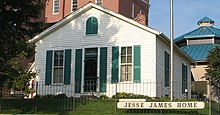
Jesse James's home in St. Joseph, where he was shot (currently at the grounds of the Patee House)
With his gang nearly annihilated, James trusted only the Ford brothers,
Charley and
Robert.
[47] Although Charley had been out on raids with James, Bob was an eager new recruit. For protection, James asked the Ford brothers to move in with him and his family. James had often stayed with their sister Martha Bolton and, according to rumor, he was "smitten" with her.
[2] James did not know that Bob Ford had been conducting secret negotiations with
Thomas T. Crittenden, the Missouri governor, to bring in the famous outlaw.
[47] Crittenden had made capture of the James brothers his top priority; in his inaugural address he declared that no political motives could be allowed to keep them from justice. Barred by law from offering a sufficiently large reward, he had turned to the railroad and express corporations to put up a $5,000 bounty for each of them.
[2]On April 3, 1882, after eating breakfast, the Fords and James prepared to depart for another robbery. They went in and out of the house to ready the horses. As it was an unusually hot day, James removed his coat, then declared that he should remove his firearms as well, lest he look suspicious. Noticing a dusty picture on the wall, he stood on a chair to clean it. Bob Ford shot James in the back of the head.
[48][49][50] James' two previous bullet wounds and partially missing middle finger served to positively identify the body.
[12]The murder of Jesse James became a national sensation. The Fords made no attempt to hide their role. Indeed, Robert Ford wired the governor to claim his reward. Crowds pressed into the little house in St. Joseph to see the dead bandit, even while the Ford brothers surrendered to the authorities but they were dismayed to find that they were charged with
first degree murder. In the course of a single day, the Ford brothers were indicted, pleaded guilty, were sentenced to death by
hanging, and two hours later were granted a full pardon by Governor Crittenden.
[51]The governor's quick pardon suggested that he knew the brothers intended to kill James rather than capture him. Like many who knew James, the Ford brothers never believed it was practical to try to take him into custody.
[citation needed]The implication that the chief executive of Missouri conspired to kill a private citizen startled the public and added to James' notoriety.
[52][53][54]After receiving a small portion of the reward, the Fords fled Missouri. Law enforcement officials active in the plan also shared the bounty. Later the Ford brothers starred in a touring stage show in which they reenacted the shooting.
[55][56]Suffering from
tuberculosis (then incurable) and a
morphine addiction, Charley Ford committed suicide on May 6, 1884, in
Richmond, Missouri. Bob Ford operated a tent saloon in
Creede, Colorado. On June 8, 1892, a man named
Edward O'Kelley, went to Creede, loaded a double barrel shotgun, entered Ford's saloon and said "Hello, Bob" before shooting Bob Ford in the throat, killing him instantly. O'Kelley was sentenced to life in prison. O'Kelley's sentence was subsequently commuted because of a 7,000 signature petition in favor of his release. The governor pardoned him on October 3, 1902.
[57]James' mother Zerelda Samuel wrote the following epitaph for him:
In Loving Memory of my Beloved Son, Murdered by a Traitor and Coward Whose Name is not Worthy to Appear Here.[47] James's widow Zee died alone and in
poverty.
Rumors of survival
Rumors of Jesse James's survival proliferated almost as soon as the newspapers announced his death. Some said that Robert Ford killed someone other than James, in an elaborate plot to allow him to escape justice. These tales have received little credence, then or later. None of James's biographers has accepted them as plausible. The body buried in Kearney, Missouri, as Jesse James's was exhumed in 1995 and subjected to
mitochondrial DNA typing. The report, prepared by Anne C. Stone, Ph.D., James E. Starrs, L.L.M., and Mark Stoneking, Ph.D., stated the mtDNA recovered from the remains was consistent with the mtDNA of one of James's relatives in the female line.
[58] This theme resurfaced in a 2009 documentary,
Jesse James' Hidden Treasure, which aired on the
History Channel. The documentary was dismissed as pseudo-history and pseudo-science by historian Nancy Samuelson in a review she wrote for the Winter, 2009-2010 edition of
The James-Younger Gang Journal.
[59]One prominent claimant was
J. Frank Dalton, who died August 15, 1951, in
Granbury, Texas. Dalton was allegedly 101 years old at the time of his first public appearance, in May 1948. His story did not hold up to questioning from James' surviving relatives.
[60]Legacy and controversies

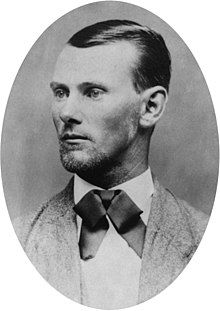


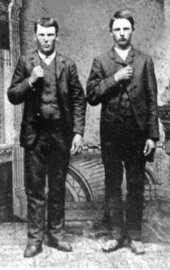






No comments:
Post a Comment